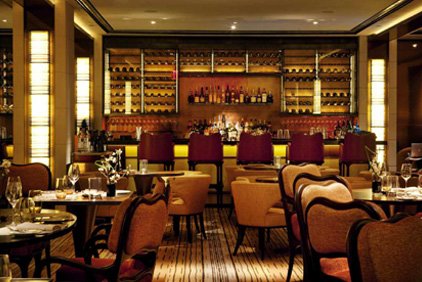Untitled
 Monday, June 20, 2011 at 02:38PM
Monday, June 20, 2011 at 02:38PM 
Note: Untitled closed in October 2014 as part of the Whitney’s move from the Upper East Side to the Meatpacking District. It is expected to re-open there in the spring of 2015 with Gramercy Tavern’s Michael Anthony as executive chef.
*
Danny Meyer is about as close to restaurant royalty as there is in this town. He has put his name on a wide variety of cuisines and concepts, from casual to formal, and he has never had a flop. (Tabla, his Indian restaurant, closed in 2010, but only after 15 years—certainly not a failure, by any reckoning.)
One factor in his success is that—except for his burger stand, Shake Shack—he has never opened outside of New York City, where he can personally supervise to the attentive service that his restaurants are famous for. Whether you like the food or not, there’s no doubt you’ll be treated well.
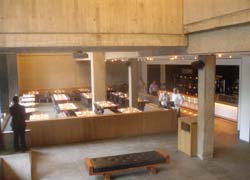 Meyer’s latest project, Untitled, carries some risks. Located in the basement of the Whitney Museum, the odd name is a pun on the establishment’s fondness for avant garde modern art works that lack titles.
Meyer’s latest project, Untitled, carries some risks. Located in the basement of the Whitney Museum, the odd name is a pun on the establishment’s fondness for avant garde modern art works that lack titles.
The space, which was formerly Sarabeth’s Kitchen, is needed frequently for evening events, so it serves dinner only three nights a week (Fridays to Sundays). At breakfast and lunch, it serves sandwiches, salads, pastries, and the like.
Danny Meyer has a deep bench. When he opens a new restaurant, he reaches down to the triple-A farm team and promotes someone to the big leagues. Chris Bradley, the lucky guy at Untitled, worked four years at Gramercy Tavern as a sous chef and executive sous chef.
 As the kitchen is quite small, the dinner menu is limited to a $46 prix fixe, where everyone gets the same appetizer, side dishes, and desserts. The only choice is the entrée: meat, fish, or vegetarian. It’s updated every week and posted on the website. (Last weekend’s menu is shown above; click on the image for a larger view.)
As the kitchen is quite small, the dinner menu is limited to a $46 prix fixe, where everyone gets the same appetizer, side dishes, and desserts. The only choice is the entrée: meat, fish, or vegetarian. It’s updated every week and posted on the website. (Last weekend’s menu is shown above; click on the image for a larger view.)
The wine cellar is also limited, with 5 whites and 5 reds, but you can bring in outside wine for just $10 corkage.
Untitled reminds me of Torrisi Italian Specialties, another restaurant that forces everyone into the same fixed menu, with a limited entrée choice being the only decision the customer makes. Torrisi costs $4 more and offers a few more courses, but not necessarily better food. Torrisi has an attitude, fostered by fawning critics who imagine it’s better than it is. If you build a Torrisi without the pretension, one that is larger, more comfortable, and more attractive; one that takes reservations and has better service, then you’ve got Untitled.
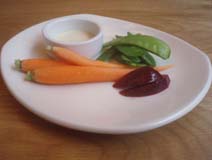
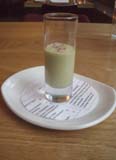
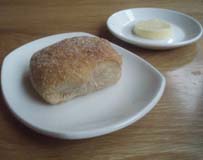
The meal starts with fresh vegetables and dipping sauce (above left); a thick, chilled avocado soup with specks of blue and red onion as amuse bouche (above center); and a warm roll with soft butter (above right).
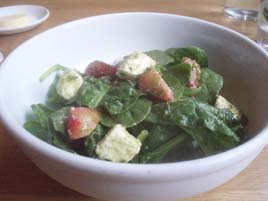
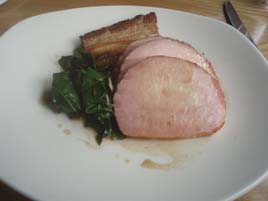
I loved the Baby Spinach Salad (above left) with goat cheese, strawberries, and a tarragon vinaigrette; and also the main course, Pork Loin & Belly (above right) on a bed of spigarello. (I didn’t taste much of the garlic and chili mentioned on the menu, but the dish didn’t need them either.) Side dishes, served family style, included a Carrot & Barley Risotto (below left) and a Zucchini–Tomato Gratin (below center).
None of this was ground-breaking or complex food, but it was very much in the Gramercy Tavern greenmarket esthetic—lists of purveyors are written on a chalkboard above the bar. On a value basis, I would rather dine here than Gramercy.
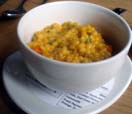
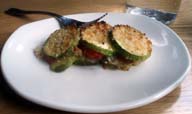

I found the dessert less impressive, a forgettable Blueberry–Lemon Meringue Pie (above right) that you could find at just about any diner. How hard could it be, to offer at least one other option to guests who don’t want that much sugar?
As I was dining alone, I chose the two house cocktails over wine. Both ($12) were excellent: a Bourbon Lemonade (basil-infused lemonade, Maker’s Mark, mint leaves); and the Hemingway (white rum, prosecco, lemon and lime juice).
The bright, attractive space admits an abundance of outside light. Starchitect David Rockwell designed it, and used plenty of the blond woods he’s so fond of. The restaurant seats 70 at the tables and 10 at the bar; just 14 seats were occupied when I left, a bit after 7:00 p.m. on a Friday evening. However, Friday dinner service was only recently added (it was only Saturdays and Sundays, at first), and the word might not be out yet. The service, of course, was according to the Danny Meyer playbook.
If Untitled had a full menu, it might be a two-star restaurant. Points need to be deducted for a restaurant that offers so few choices. If you have any food allergies or other limitations, you may find that the limited options at Untitled become no choice at all. If you don’t mind being shoehorned into the menu du jour, you get a good value out of your $46 investment.
Untitled at the Whitney (945 Madison Ave. at 75th Street, Upper East Side)
Food: ★
Service: ★½
Ambiance: ★
Overall: ★






















































